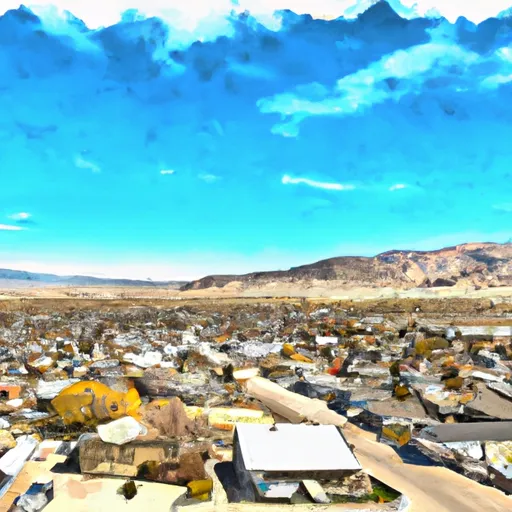-
 Snoflo Premium
Snoflo Premium
Get unlimited access to all our content
With no Ad interruptions! - Start Your Free Trial Login with existing account
Smith
Eden Index
Climate
8.5
•
Recreation
4.2
•
Community
1.0
•
Safeguard
5.1/10

Smith, Nevada is a small town located in the western region of the United States. Known for its picturesque landscapes and diverse outdoor recreation opportunities, Smith offers a unique experience to residents and visitors alike. The climate in Smith is characterized by hot, dry summers and mild, cool winters. With an average annual temperature of 65°F, it provides favorable conditions for outdoor activities throughout the year.
Hydrologically, Smith benefits from several bodies of water, including rivers, lakes, and reservoirs. These water sources not only offer scenic beauty but also provide ample opportunities for fishing, boating, and water sports. The constituents of Smith's hydrology also support diverse wildlife, making it an ideal destination for birdwatching and nature enthusiasts.
In terms of outdoor recreation, Smith boasts an array of activities for adventure seekers. Hiking and biking trails wind through the scenic landscapes, offering stunning views and opportunities for exploration. The surrounding mountains provide excellent terrain for camping, rock climbing, and even winter sports like skiing and snowboarding.
In conclusion, Smith, Nevada offers a pleasant climate, diverse hydrology constituents, and a range of outdoor recreation opportunities. Whether you enjoy water activities, hiking, or simply immersing yourself in nature, Smith is an ideal destination to experience the beauty and tranquility of the great outdoors.
What is the Eden Index?
The Snoflo Eden Index serves as a comprehensive rating system for regions, evaluating their desirability through a holistic assessment of climate health, outdoor recreation opportunities, and natural disaster risk, acknowledging the profound impact of these factors on livability and well-being.
Climate Health Indicator (CHI): 8.5
Smith receives approximately
198mm of rain per year,
with humidity levels near 60%
and air temperatures averaging around
11°C.
Smith has a plant hardyness factor of
6, meaning
plants and agriculture in this region thrive during a short period during spring and early summer. Most
plants will die off during the colder winter months.
By considering the ideal temperature range, reliable water supplies, clean air, and stable seasonal rain or snowpacks, the Climate Health Indicator (CHI) underscores the significance of a healthy climate as the foundation for quality living.
A healthy climate is paramount for ensuring a high quality of life and livability in a region, fostering both physical well-being and environmental harmony. This can be characterized by ideal temperatures, reliable access to water supplies, clean air, and consistent seasonal rain or snowpacks.
Weather Forecast
Streamflow Conditions
Walker
Area Rivers
Walker
Snowpack Depths
Walker
Reservoir Storage Capacity
Walker
Groundwater Levels
Recreational Opportunity Index (ROI): 4.2
The Recreational Opportunity Index (ROI) recognizes the value of outdoor recreational options, such as parks, hiking trails, camping sites, and fishing spots, while acknowledging that climate plays a pivotal role in ensuring the comfort and consistency of these experiences.
Access to outdoor recreational opportunities, encompassing activities such as parks, hiking, camping, and fishing, is crucial for overall well-being, and the climate plays a pivotal role in enabling and enhancing these experiences, ensuring that individuals can engage in nature-based activities comfortably and consistently.
Camping Areas
| Campground | Campsites | Reservations | Toilets | Showers | Elevation |
|---|---|---|---|---|---|
| Bootleg | 63 | 6,441 ft | |||
| Wilson Canyon | None | 4,676 ft | |||
| Sonora Bridge | 23 | 6,788 ft | |||
| Topaz Lake | 70 | 5,007 ft | |||
| Chris Flat | 15 | 6,896 ft | |||
| Desert Creek | 20 | 6,279 ft |
Nearby Fishing
Nearby Ski Areas
Catastrophe Safeguard Index (CSI):
The Catastrophe Safeguard Index (CSI) recognizes that natural disaster risk, encompassing floods, fires, hurricanes, and tornadoes, can drastically affect safety and the overall appeal of an area.
The level of natural disaster risk in a region significantly affects safety and the overall livability, with climate change amplifying these risks by potentially increasing the frequency and intensity of events like floods, fires, hurricanes, and tornadoes, thereby posing substantial challenges to community resilience and well-being.
Community Resilience Indicator (CRI): 1.0
The Community Resilience Indicator (CRI) recognizes that education, healthcare, and socioeconomics are crucial to the well-being of a region. The CRI acknowledges the profound impact of these elements on residents' overall quality of life. By evaluating educational resources, healthcare accessibility, and economic inclusivity, the index captures the essential aspects that contribute to a thriving community, fostering resident satisfaction, equity, and social cohesion.

